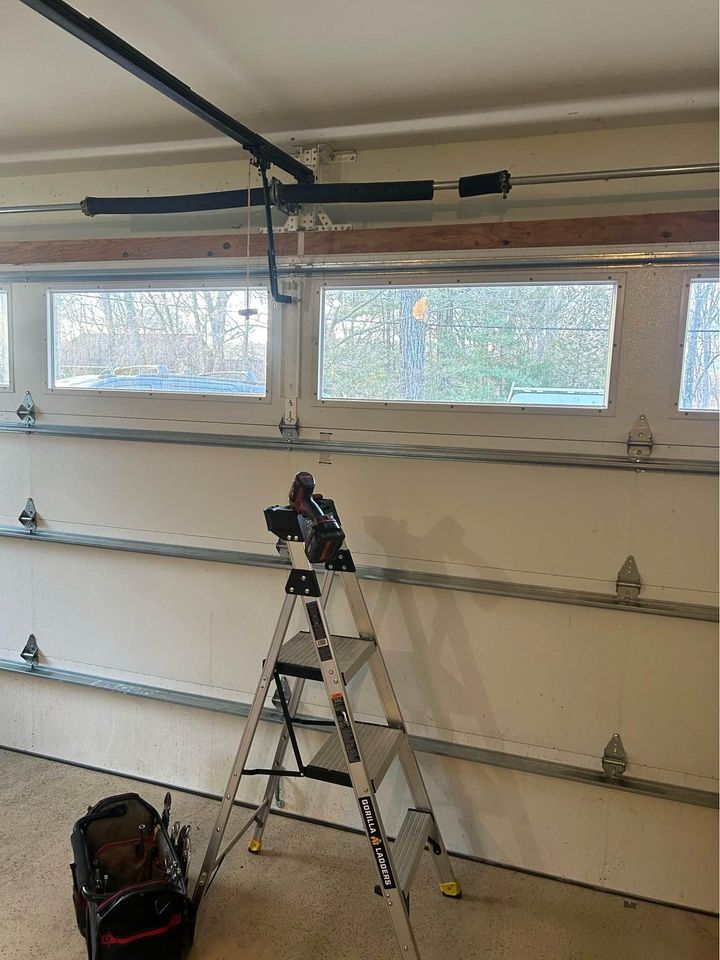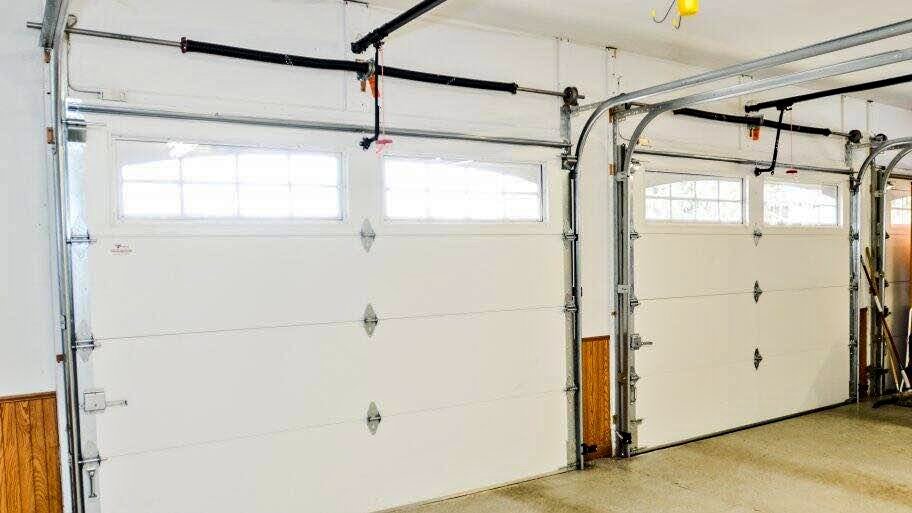
Is your garage door not closing properly? Are you noticing a gap at the bottom, letting in drafts or pests? It might be time to adjust your garage door. Whether you’re dealing with a misaligned door, a gap at the bottom, or an issue with the travel settings, this comprehensive guide will walk you through the process of adjusting your garage door. You can ensure smooth operation, proper sealing, and enhanced security with just a few simple steps and the right tools. So, let’s dive in and learn how to adjust your garage door for optimal performance.
Adjusting and Fixing the Garage Door Components
Before adjusting your garage door, it’s crucial to conduct a thorough inspection to identify any potential issues. By examining the tracks, springs, and rollers, you can determine if adjustments are needed to ensure proper alignment and functionality. Let’s delve into each component and learn how to inspect and correct any issues that may arise.
Fixing Cables on a Garage Door
Over time, the cables on a garage door may become loose, frayed, or damaged, affecting the door’s operation and safety. If you notice any issues with the cables, it’s essential to address them promptly. Here’s a step-by-step guide on how to fix cables on a garage door:
- Safety First: Before attempting any repairs, ensure the garage door is closed and disconnect the power to the opener to prevent any accidental movement.
- Inspect the Cables: Carefully examine the cables for signs of fraying, wear, or damage. If you notice any issues, it’s crucial to replace the cables entirely rather than attempting repairs.
- Release Tension: Using a pair of locking pliers or C-clamps, secure the garage door track below the bottom roller to prevent the door from moving.
- Loosen the Cable Drum: Locate the cable drum near the top of the garage door on both sides. Using a wrench or socket set, loosen the set screws on the cable drum to release tension.
- Remove Old Cables: With the tension released, disconnect the damaged cables from the bottom bracket and cable drum. Be cautious as the cables may still be under some tension.
- Install New Cables: Install the new cables, starting with the bottom bracket and then attaching them to the cable drum. Ensure they are properly seated and aligned.
- Tighten the Cable Drum: Gradually tighten the set screws on the cable drum, ensuring the cables wind evenly around the drum. Maintain tension while tightening to keep the cables secure.
- Check Cable Tension: Raise the garage door manually to check if the cables are properly tensioned. The door should move smoothly without any slack or excessive tightness in the cables.
- Test the Door: Reconnect the power to the opener and test the garage door’s operation. Ensure it opens and closes smoothly without any issues or cable slippage.
- Regular Maintenance: To prevent cable issues in the future, perform regular maintenance on your garage door, including lubricating moving parts and visually inspecting the cables for any signs of wear or damage.
Adjusting the Tracks

- Tools Needed: Stepladder, wrench, level, rubber mallet, socket set (if applicable).
- Step 1: Inspection: Start by visually inspecting the tracks for any misalignment, gaps, or damage. Look for dents, bends, or obstacles that hinder the door’s movement.
- Step 2: Alignment: Use a level to check the tracks’ alignment. Adjust any misaligned sections by gently tapping them with a rubber mallet. Ensure the tracks are parallel to each other and securely attached to the wall and ceiling.
- Step 3: Tightening Bolts: Check the bolts and brackets holding the tracks in place. If any are loose, use a wrench or socket set to tighten them.
- Step 4: Lubrication: Apply a silicone-based lubricant to the tracks to reduce friction and ensure smooth door movement. Wipe off any excess lubricant.
- Step 5: Testing: Open and close the door multiple times to verify the smooth operation of the tracks. Make further adjustments if necessary.
How to adjust garage door springs
The springs of your garage door play a crucial role in supporting its weight. Inspect and adjust the springs as necessary using these steps:
- Tools Needed: Stepladder, winding bars, safety gloves.
- Step 1: Safety Precautions: Before adjusting the springs, ensure you understand the risks involved. Wear safety gloves and exercise caution throughout the process. If you are unsure or uncomfortable, it’s best to consult a professional.
- Step 2: Determining Spring Type: Identify whether your door has torsion springs or extension springs. The adjustment process varies for each type.
- Step 3: Torsion Springs: For torsion springs, use winding bars to adjust the tension. Insert the winding bar into one of the winding cone holes and turn it slowly in the direction specified by the manufacturer or professional. Make small adjustments, testing the door’s balance after each turn. Seek professional assistance if needed.
- Step 4: Extension Springs: For extension springs, adjust the tension by moving the S-hook to a different hole on the track. Moving it closer to the door increases tension while moving it away decreases tension. Test the door’s balance after each adjustment.
- Step 5: Testing: After adjusting the springs, open and close the door to check for smooth and balanced operation. Ensure the door stays in position when partially opened.
Adjusting the tension of the springs should be done with caution as it can be dangerous. Follow the manufacturer’s guidelines or consult a professional if you are unsure about the adjustment process. It is recommended to seek the assistance of a qualified technician for spring adjustments.
Adjusting the Rollers
The rollers are essential for smooth door movement along the tracks. Inspect and maintain the rollers using these steps:
- Tools Needed: Stepladder, socket set, silicone-based lubricant.
- Step 1: Inspection: Carefully examine the rollers for signs of wear, damage, or misalignment. Look for cracks, chips, or excessive wobbling. Inspect both the rollers on the sides of the door and the ones attached to the bottom section of the door.
- Step 2: Lubrication: Apply a silicone-based garage door lubricant to ensure smooth operation of the rollers. Lubricate the rollers and their bearings, but avoid applying excessive lubrication that may attract dirt and debris. Proper lubrication helps reduce friction and prolongs the lifespan of the rollers.
- Step 3: Roller Adjustment: Use a socket set to loosen the bolts holding the roller brackets. Adjust the roller position by moving it up or down, aligning it with the track. Tighten the bolts securely.
- Step 4: Testing: Open and close the door multiple times to ensure the rollers move smoothly along the tracks. Make further adjustments if needed.
If you notice any damaged or worn-out rollers, consider replacing them to maintain optimal performance. Damaged rollers can cause the door to operate unevenly or produce excessive noise. Consult the manufacturer’s guidelines or seek professional assistance for roller replacement.
Adjusting Travel Limit Switches

The travel limit switches are an important component of the garage door opener system that determines the door’s open and close positions. If your garage door doesn’t fully open or close, or if it reverses before reaching the desired position, adjusting the travel limit switches can help resolve the issue. Here’s how to adjust them:
- Locating the Travel Limit Switches: Inspect your garage door opener unit and locate the travel limit adjustment screws. These screws are usually marked with an arrow or labeled “up” and “down” to indicate their purpose. They are typically found near the motor unit or on the back panel of the opener.
- Identifying the Up and Down Travel Switches: Depending on the type of garage door opener, you may have either adjustment screws or travel switches. If you have travel switches, you’ll see a small lever arm extending down and mounted to the rail. The switch closest to the opener unit is the up travel switch, and the one closest to the wall is the down travel switch.
- Adjusting Travel Limit Adjustment Screws: If your opener has adjustment screws, use a flat-head screwdriver to turn the appropriate screw counterclockwise to lower the down position or clockwise to raise the up position. Refer to the arrow or label near the adjustment screw for the correct direction. Typically, each full rotation of the adjustment screw results in a 2-3 inch adjustment in the travel limit.
- Adjusting Travel Switches: If your opener has travel switches, adjusting them is straightforward. Start by loosening the one or two set screws that hold the switch in place. Then, move the switch up or down the rail to the desired position. Finally, re-tighten the set screw(s) securely. If your garage door was not originally set up correctly, you might also need to adjust the connection arm that runs from the trolley to the door in extreme cases.
- Testing the Adjustment: After making the necessary adjustments, test the garage door’s operation. Open the door fully, stop the travel, and then initiate the closing motion. The door should reach the new adjusted down position and seal properly at the bottom. Likewise, when opening, the door should reach the adjusted up position without any issues.
FAQs – Garage Door Adjustments
Garage door sensors are essential for safety, ensuring that the door doesn’t close if there’s an obstruction. To adjust them, start by cleaning the sensor lenses and ensuring they are aligned. Adjust the sensor brackets if necessary, making sure they are secure and properly aligned with each other. Test the sensors by closing the door and checking if it stops and reverses when an object is placed in the sensor’s path.
If your garage door won’t close, check for any obstructions in the door’s path. Ensure the sensors are aligned and clean. Lubricate the moving parts, including rollers, tracks, and hinges. Inspect the cables and springs for any damage. If the problem persists, consult a professional technician to diagnose and resolve the issue.
To fix a garage door gap on one side, check the tracks and ensure they are properly aligned. Adjust the track brackets and use a level to ensure they are plumb. Inspect the rollers and replace any damaged or worn-out ones. If the gap persists, consult a professional technician to assess and resolve the issue.
Garage door height adjustment typically involves adjusting the travel limit screws or switches on the opener unit. Follow the manufacturer’s instructions for your specific opener model to make the necessary adjustments. It’s essential to maintain the door’s balance and consult a professional if you’re unsure about the process.
Adjusting a garage door motor usually involves adjusting the travel limit screws or switches on the opener unit. Refer to the manufacturer’s instructions for your specific opener model to perform the adjustments correctly. Avoid excessive adjustments that may cause the door to overtravel or strain the motor.
To adjust a garage door top gap, inspect the weatherstripping and replace it if damaged. Check the alignment of the tracks and adjust them if necessary. You may need to adjust the travel limit screws or switches to fine-tune the door’s closing position. If the gap persists, consult a professional technician for further assessment and adjustment.
It’s recommended to have a professional tune-up for your garage door at least once a year. During a tune-up, the technician will inspect and lubricate all moving parts, adjust the springs and cables, tighten the hardware, and ensure the door’s proper balance and operation. Regular maintenance helps prolong the lifespan of your garage door and prevents potential issues.
Final words
Taking care of your garage door not only enhances convenience and security but also helps prevent costly repairs in the future. By being proactive and proactive in maintaining and adjusting your garage door, you can enjoy a functional and reliable entrance to your home for years to come.
Last Updated on June 6, 2023

Dustin Hopkins has over 12 years in the cleaning industry, working in the past for one of the top 5 cleaning companies in the US. Currently, he is the chief editor of CleaningRank.com and the proud father of a 5-year-old, Chris.
